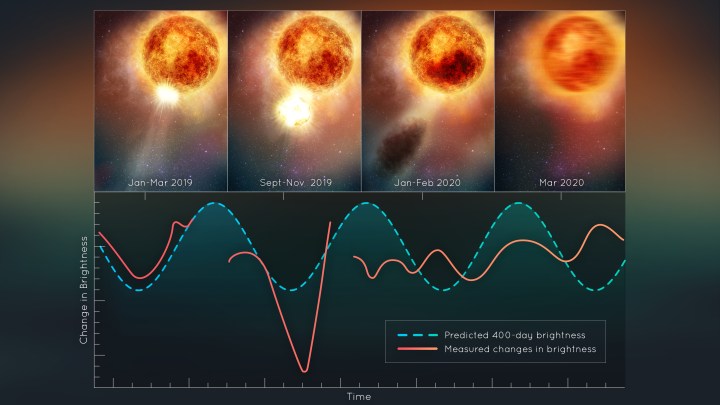One of the brightest stars in the sky, the nearby red supergiant Betelgeuse, has been the source of fascination in the last few years as it dimmed and then re-brightened dramatically. Now, new data from the Hubble Space Telescope shows that the star blew off a huge chunk of its mass in 2019, creating a cloud of dust that obscured its light and caused the dimming effect.
The explosion of such a big chunk of matter is a rare event called a surface mass ejection, similar to the coronal mass ejection events seen in our sun and other stars but much, much bigger. The surface mass ejection blew off an almost unimaginable 400 billion times as much mass as a standard coronal mass ejection, creating huge changes to the star’s structure and behavior.

Hubble data was used along with data from ground-based telescopes to create this illustration, showing how dramatically the star’s brightness changed as it threw off mass and formed a large dust cloud. This event is a brand new insight into the lives of huge red stars like Betelgeuse, which is coming toward the end period of its life and will eventually go supernova.
“We’ve never before seen a huge mass ejection of the surface of a star,” said lead researcher Andrea Dupree of the Center for Astrophysics, Harvard and Smithsonian in a statement. “We are left with something going on that we don’t completely understand. It’s a totally new phenomenon that we can observe directly and resolve surface details with Hubble. We’re watching stellar evolution in real time.”
Dupree also said that the event had left its mark on the structure of Betelgeuse, with the interior behaving particularly strangely and “sort of bouncing.” The mass of matter blown off the star was several times the mass of our moon, and its loss will change the star’s rate of brightness pulsation as well. Previously, Betelgeuse had brightened and dimmed slowly over a 400-day cycle, but now this cycle has been disrupted and scientists are unsure how the star will develop in the future.



